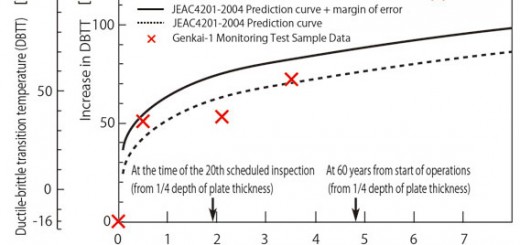CNIC Statement: Withdraw the “Extension of Operation Period” Proposal for Nuclear Power Plants
11 October 2022
On October 5, at a regular meeting of the Nuclear Regulation Authority (NRA), Chairman Yamanaka responded to the Ministry of Economy, Trade and Industry (METI) proposal to eliminate the rule stipulated in the Nuclear Reactor Regulation Law that the operating period of a nuclear power plant shall be 40 years in principle, with one 20-year extension permitted only in special cases, saying, “The operating period is a policy decision regarding how nuclear power should be used…The METI proposal to eliminate the (40-year operating) rule is not a matter for the NRA to express its opinion on.” This statement was met with no opposition from the other four commissioners.
The NRA’s stance is absolutely outrageous.
The 40-year rule was introduced in June 2012 based on the lessons learned from the tragic nuclear accident at TEPCO’s Fukushima Daiichi Nuclear Power Plant, where Unit 1 of the three reactors that suffered meltdown in March 2011 was about to enter its 40th year. More than eleven and a half years have passed without any prospect of a resolution to the accident, and even the “state of emergency declaration” has not yet been lifted.
Meanwhile, at the METI subcommittee on nuclear energy, the majority of the committee members are trying to steer the committee toward the restart of nuclear power plants while repeating the phrase, “safety first” in the same breath. On October 7, Prime Minister Kishida, when asked by the opposition parties during the resumed deliberations in the Diet, also used the same phrase “safety first.”
We would like to ask how this “safety” can be verified.
The biggest problem is how to avoid neutron irradiation embrittlement, a dangerous condition of the reactor pressure vessel, which is effectively the heart of a nuclear power plant. Generally, the metals used in reactor vessels become embrittled as they are exposed to neutrons flying around the reactor for a long period of time, but there is no technology to determine the degree of embrittlement through nondestructive testing. The only way to estimate the degree of embrittlement is to remove several monitoring specimens inserted into the reactor vessel during periodic inspections, but this is not always reliable. The JEAC 4201-2007, an electrotechnical regulation enacted in 2007, is the standard for using this method, but it was endorsed and implemented by the now disbanded Nuclear and Industrial Safety Agency (NISA). Subsequently, in 2015, leading experts in our country pointed out a fundamental error in this standard. The NRA and the NRA Secretariat have acknowledged this. However, even after seven years, this erroneous standard has not been rectified. In addition, the number of monitoring test specimens, which are supposed to check the embrittlement status, is limited, so the deterioration status is not being checked frequently. If the operation period is extended beyond 40 years, embrittlement will most certainly progress, yet there are insufficient monitoring specimens to check the embrittlement status. Although the tested monitoring specimens are recycled, the number that can be recycled is limited, and in any case, they are not equivalent because they have undergone some form of modification.
This shows that there is no method to actually verify safety.
If we are to use nuclear power, all people living in Japan and beyond will have to live with the risk of its existence. If we stop using nuclear power, this risk can be reduced to zero.
The NRA and the government must decide whether to follow the will of the industry or the will of the people. At the very least, the “extended operation period” proposal should be withdrawn.

